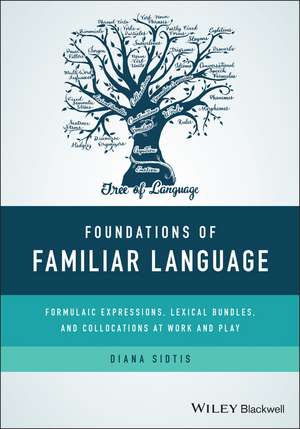Foundations of Familiar Language – Formulaic Expressions, Lexical Bundles, and Collocations at Work and Play
Autor D Sidtisen Limba Engleză Paperback – 19 dec 2021
Preț: 357.80 lei
Nou
Puncte Express: 537
Preț estimativ în valută:
68.47€ • 74.35$ • 57.52£
68.47€ • 74.35$ • 57.52£
Carte tipărită la comandă
Livrare economică 22 aprilie-06 mai
Preluare comenzi: 021 569.72.76
Specificații
ISBN-13: 9781119163329
ISBN-10: 1119163323
Pagini: 464
Dimensiuni: 181 x 253 x 25 mm
Greutate: 0.8 kg
Editura: Wiley
Locul publicării:Hoboken, United States
ISBN-10: 1119163323
Pagini: 464
Dimensiuni: 181 x 253 x 25 mm
Greutate: 0.8 kg
Editura: Wiley
Locul publicării:Hoboken, United States
Cuprins
Acknowledgments xi
Preface xii
1 Introduction 1
Incidence of Familiar Language Exemplars 12
Where Do Fixed, Familiar Expressions Come From? 16
2 Classification 26
Identification 36
Three Classes of Familiar Expressions: Formulaic Expressions, Lexical Bundles, Collocations 37
Formulaic Expressions 40
Lexical Bundles 80
Collocations 86
Overview of Characteristics and Functions of Familiar Language 104
How Formulaic Expressions, Lexical Bundles, and Collocations Differ 114
3 How Is Familiar Language Acquired? 117
Frequency of Exposure: History and Veridicality 118
Acquisition: Role of Emotion and Familiarity 123
Acquisition: Memory for Speech and Language 127
4 Acquisition 131
Several Conditions Converge to Promote Acquisition 132
Acquisition of Fixed, Familiar Expressions in the First Language 136
Acquisition of Fixed, Familiar Expressions in the Second Language 143
Familiar Language Representation Compared in First and Second Language 150
5 Prosodic and Phonetic Characteristics of Fixed, Familiar Expressions 155
Stereotyped Prosodic Form in Fixed Expressions 157
Detailed Knowledge of Prosodic Features 160
Acoustic Studies 163
6 Familiar Language in Psychiatric and Neurologic Disorders 169
Psychiatric Disorders 170
The Neurology of Familiar Language 181
Stroke: Residual Speech and Familiar Phrases 187
Familiar Phrases in Speech Therapy 203
Specialized Functions of the Cerebral Hemispheres 217
The Right Hemisphere and Familiar Language 222
Cortical-Subcortical Dimension 224
Functional Imaging Studies of Fixed Expressions 241
7 Summing Up: Dual- or Multiprocess Model of Language Function? 251
The Linguistic View 251
The Psychological Perspective 253
Observations from Cerebral Processing 255
Familiar Language - Its Daunting Heterogeneity 258
Appendix I: Listing Accumulated by C. Fillmore, 1973 (2050 items) 263
Appendix II: Russell Baker: New York Times, the 1978 Commandments 287
Appendix III: Selected Familiar Expressions Listed in Chiardi, 1987 289
Appendix IV: Familiar Expressions Contributed by Students as Heard in Daily Communicative Interactions 291
Appendix Va: Formulaic Expressions as Encountered Every Day Over a Few Years 295
Appendix Vb: Lexical Bundles Encountered Every Day Over the Past Few Years 302
Appendix Vc: Collocations Encountered Every Day in the Past Few Years 305
Appendix VI: Schemata Accumulated from Current Communications 309
Appendix VII: German Proverbs Drawn from Hain (1951), Set Up in Survey Style to Assess Knowledge of Current Native Speakers of German 317
Appendix VIII: A Dialogue Composed Entirely of Movie Titles 321
Appendix IX: Formulaic Expressions Captured from On-line Viewing of the Film "Some Like It Hot" 323
Appendix X: Familiar Expressions from Newspapers: Class, Subset, Provenance, and Change of Form or Meaning 331
Appendix XI: Essential Nomenclature for Cerebral Structures: Definition, Location, and Function 343
Appendix XII: Matched Novel and Familiar Expressions; Stimuli for Rammell, Pisoni, and Van Lancker Sidtis (2018) Study 345
Appendix XIIIa: Northridge Evaluation of Formulas, Idioms, and Proverbs in Social Situations 348
Appendix XIIIb: Northridge Evaluation of Formulas, Idioms, and Proverbs in Social Situations 351
Appendix XIV: Familiar and Novel Language Comprehension Protocol: Instructions and Answer Sheet 355
Appendix XV: Test Format for Survey: Some Like It Hot Protocol 365
Appendix XVI: Sample "Grid" from 2006 Used in Preliminary Studies to Document Subsets of Familiar Expressions in Healthy and Neurological Persons 368
Appendix XVII: Responsive Naming Test with Expected Answers (Garidis et al., 2009) 377
Appendix XVIII: Selected Books and Articles Listing Formulaic Expressions, Lexical Bundles, and Collocations 379
Glossary 381
References 386
Index 439
Notă biografică
Diana Sidtis (formerly Van Lancker), PhD, CCC/SLP, is Professor Emerita of Communicative Sciences and Disorders at New York University and Research Scientist at the Nathan Kline Institute for Psychiatric Research in Orangeburg, New York. She is the co-author of Foundations of Voice Studies, which won the 2011 Prose Award for Scholarly Excellence in Linguistics from the American Publishers Association. Her research examining voice, aphasia, motor speech, prosody, and formulaic language has been published in more than 130 peer-reviewed journals and other publications.
